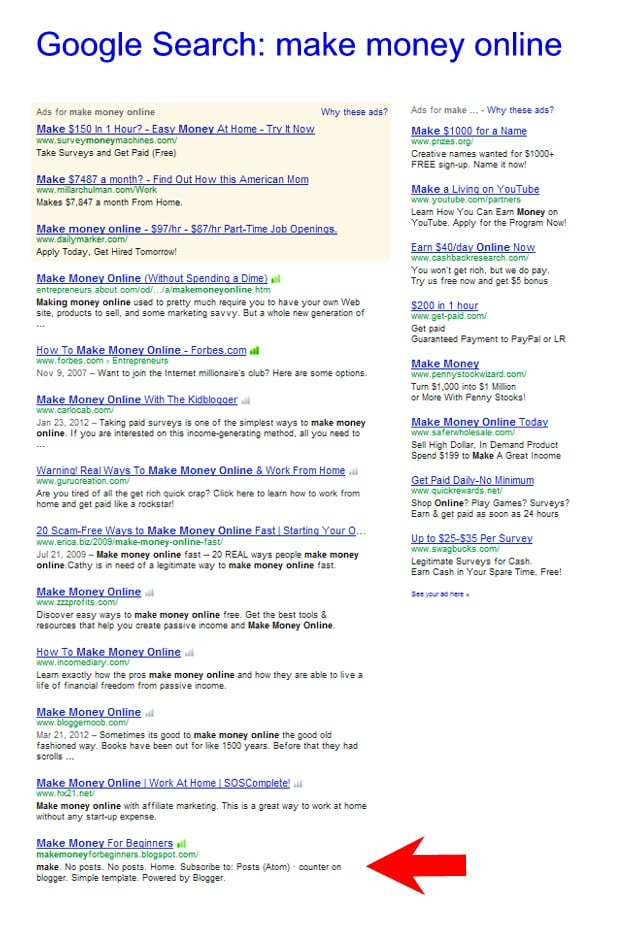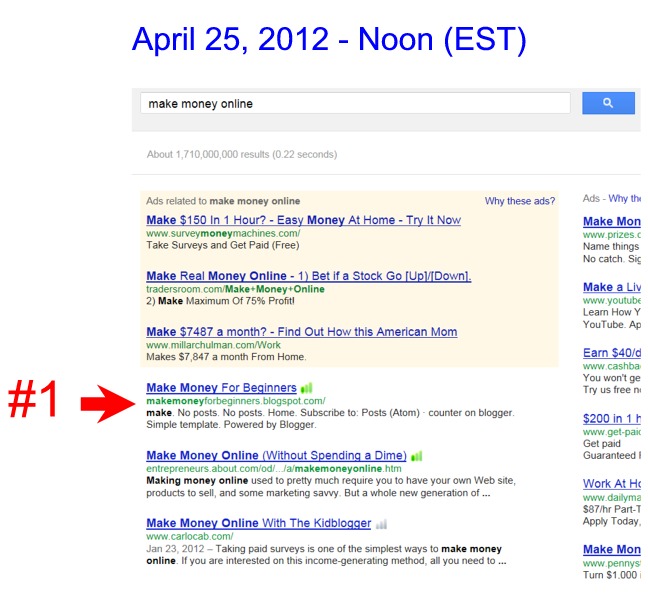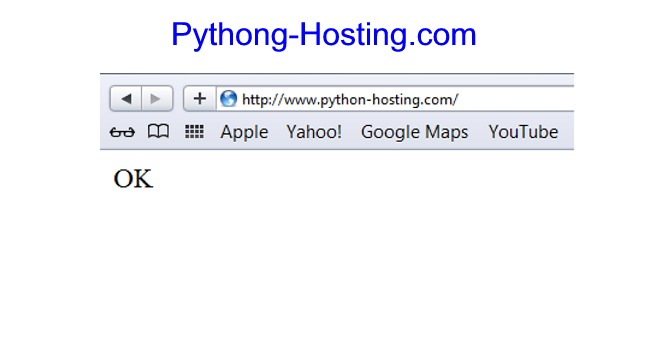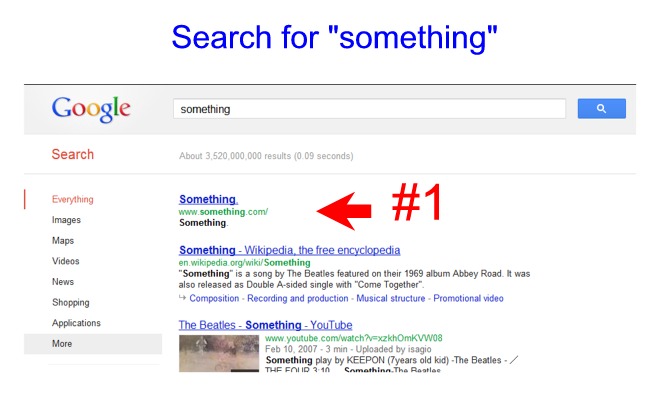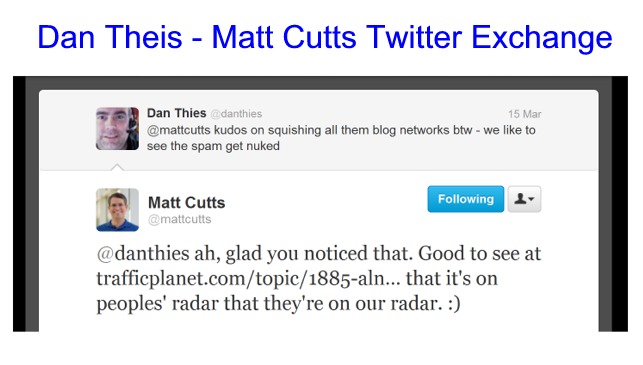The Rise of Negative SEO
OK, let’s start here: There’s a lot of craziness happening in Google’s search results lately. Some of it seems to possibly be related to some algorithm changes that were made recently, but some of it seems more deeply rooted than recent changes.
It’s hard to say why certain things are happening, and it may sound preposterous, but I would guess that even Google itself doesn’t know why some of it is happening.
How can I say that? Well, read on and look at some of the examples in this post. You may come to the same conclusion. There’s no way Google would allow some of this stuff to happen if it could prevent it.
“Make Quality Content”
We’ve all heard it a million times: making quality content is the answer.
If you had done a search recently for the very lucrative keyword phrase “make money online” in Google, however, you would have seen something odd pop up in the #10 position on the first page.
And this is what the site looks like on the inside.
When this was noticed, people in the SEO community started talking about it (and linking to it). It then shot up to the #1 position on the first page.
As of this writing, however, it is now gone from the first page and rests around position #44. Google often hand-edits embarrassing results, and that could be the case here. But it also might be the SERPS (search engine result pages) just shaking themselves out. Still, it doesn’t deserve a spot at #44 either, obviously.
If I were to really put on my conspiracy cap, I might say that it was hand-edited down to #44 to make it look as if it were slowly slipping out of the rankings, and then in a day or two (perhaps by the time you read this post), it will have been hand-edited completely out of the SERPS altogether.
How Did It Get There in the First Place?
Conspiracy aside, the question still remains: How did it get there in the first place?
Some have shed a little light on the domain. Supposedly it was once an active site that actually held the top spot for the term “make money online.” Google then deemed the site to be a spam site, and they shut the owner out of it years ago. As it was a BlogSpot blog, and Google owns BlogSpot, they could do this. (Some say it was NOT a spam site, but never having seen the original site, I can’t say.)
While all of that makes for interesting backstory, it doesn’t change the fact that the current site looks like this:
Fluke!
Of course there can be flukes, even in very competitive spaces such as the “make money online” space.
But that’s not the only “fluke” on Google these days. Take a look at this one.
And here’s the totality of the site that comes in at the #1 spot.
And while this one isn’t exactly a money-maker, it goes to show that this is a problem that spreads across the board.
So What’s REALLY Going On?
Well, it’s hard to say what’s really going on. Obviously if Google knew what was going on, they wouldn’t have results like those above showing up where they do.
There is a chance that all this above may be related to a very recent change in Google’s algorithm. And while that technological change is, well, technological, there are some other very human-related consequences that are starting to arise from it (and things like it).
In Google’s quest to root out spammers, it would seem it may have “broke the internet.” But how could that be? Well, it may be that Google doesn’t just want to discount spammers; it seems they may want more than that. It seems they may want to punish them — and badly.
Is it this desire for revenge that’s leading Google into whacked out ranking formulas? Is this thirst for blood also turning their enemies more vicious?
Maybe.
This gets a little complicated, but let’s see if we can tie it all together.
Google’s Recent Update and Their Motivations
Google recently announced that they have come out with an updated version of their algorithm. We reported that this was coming last month. At that time, Matt Cutts (Google’s lead engineer from their Webspam team) referred to it as a way to combat “over optimization.”
Seeing that the term “over optimization” sent many in the web community into fits of derisive, mocking laughter, Google has moved away from that term and now simply calls it combating “webspam.”
Make no mistake about it, however, this update is meant to combat over-optimization. In other words, it’s meant to devalue sites that seem to have followed Google’s rules too well – for example, sites that put too many instances of a keyword on a page, or sites that get “too many” links with perfectly crafted anchor text.
The Problem in Google’s Eyes
It would appear that the problem, in Google’s eyes, is that people were beginning to more or less figure out their algorithm. Google being Google (arrogant, obnoxious, secretive, bullying, impersonal) didn’t simply want to discount these sites when they found them, they wanted to PUNISH them. They wanted to teach them a lesson. They wanted to show them who was boss. Perhaps, of course, they thought this would dissuade them from ever doing something similar in the future.
That’s all fine and dandy … unless you’ve ever seen a Kung Fu Panda movie. Even a semblance of kung fu in an animated movie can teach you some lessons about redirecting another’s energy away from you.
And that’s exactly what some have started to do. As Google charges at them full force, they have learned that they can redirect that massive Google power and determination away from them. Specifically, they have learned that they can use it to hurt others – i.e. their competition. This is known as Negative SEO.
What is Negative SEO?
Negative SEO has actually been around for a while. Some have claimed to use it for years. As long as Google was doling out penalties, anyone who wanted to could simply turn those penalties onto their competition by doing exactly what Google didn’t want them to do, only for their competitors’ sites, of course.
Comment spam? Sure, give me a 50,000.
Paid links from blog networks? Yeah, I’ll take 10,000.
Forum profile spam? Yes, please. How about 30,000? … No, wait, make it 40,000.
Foul, but No Harm
It used to be that Google said there was practically no way you could harm someone else’s rankings.
But as long as Google’s punishments were meted out blindingly and impersonally by its algorithms, of course that made no sense. If you could hurt your own site with “off-site SEO” (getting spammy inbound links, etc.), then you could obviously hurt someone else’s.
No matter what came out of the mouth of Google, there was simply no getting around that logic.
However, even though it was possible to perform Negative SEO, not many did it. Either they believed Google when they said it wasn’t possible, or they simply chose not to go down such a dark path.
FREE EBOOK
Your step-by-step roadmap to a profitable web dev business. From landing more clients to scaling like crazy.
FREE EBOOK
Plan, build, and launch your next WP site without a hitch. Our checklist makes the process easy and repeatable.
The Tides are Turning
Now, however, it seems the tides are turning in the SEO world. As Google tightens every possible noose it can find in the hopes of strangling those it deems spammers, it has unwittingly done two very important things:
- It has put the spammers in a corner with their backs against the wall, and …
- In its wild-eyed zeal, it has created a lot of collateral damage, wiping many non-spammers off the map
The Rise of Negative SEO
Group 2 above, the non-spamming collateral damage group, unfortunately, don’t matter much. They have their businesses wiped away in an instant, and they’re gone. They don’t know what happened, and there’s no one who can tell them how to fix it. They are essentially powerless in this SEO struggle.
If they’re smart, and they can muster the energy again, they come to the conclusion that they need to get away from their Google addiction. In order to do this, most turn to social media. If they can get some traction in social media, ironically enough, Google may start to love them again.
Happy ending, right?
Well, maybe not.
And the answer is “maybe not” because there is still a very pissed off Group 1 from above – those that Google has cornered.
This group doesn’t just want to “go social.” No. They want to get even.
And how will they do that? … Well, they’ll just kung fu Google’s ass.
Enter Negative SEO.
A Real Life Example
Dan Thies is pretty famous in the SEO world. He’s known as being “white hat” (as opposed to a “black hat” spammer). He’s also famous enough in the SEO world to be able to chit-chat with Matt Cutts (Head of Google’s Webspam team).
Being chums as they are, and hating spam as they do, Dan and Matt had a nice little exchange via Twitter about some actions Google recently took to devalue paid links from blog networks. (These networks are set up for the sole purpose of buying links. Typically, you buy a subscription from a network, and then submit content to them with links pointing wherever you want them to go.)
Some didn’t like that, it seems, especially a few posters from the forum TrafficPlanet.com. They called Thies “a suck-up-brown-noser.” But that wasn’t all; they decided to target Thies’ site (seofaststart.com) for a Negative SEO case study to see if they could actually negatively affect his rankings.
Results of the Case Study
The reason why many believed Google when they said you couldn’t negatively affect someone else’s rankings was fairly logical.
- If you were spamming and gaming the system, you might at first move up in the rankings.
- When Google caught on, they would simply discount your spammy links.
- You would subsequently fall in the SERPS because your rankings were built on spam that had been removed, NOT because you were “penalized” per se.
- Therefore, throwing spammy links at a legitimate site would not affect it. Google didn’t punish for spammy links; they simply discounted spammy links.
All that makes sense. And so to go after an authority site like Thies’ seofaststart.com would be a real test. Thies already had high rankings for competitive terms like “SEO” (#11 in the SERPS according to the testers). These rankings (if we are to believe Thies, and there’s no reason not to) were built from years of strictly white hat SEO. Therefore, if throwing spam links at Thies’ site affected it negatively, it would be proof of Google “punishing” sites, not simply discounting links they deemed unworthy.
So What Happened?
Well, one thing that happened was that Dan Thies (as we learn from a post he made on a Google Webmaster Central Forum) got a smart letter from his buddies at Google telling him he had spammy links pointing to his site.
These letters (that a lot of webmasters get, it seems) read in part like this:
We’ve detected that some of your site’s pages may be using techniques that are outside Google’s Webmaster Guidelines.
Specifically, look for possibly artificial or unnatural links pointing to your site that could be intended to manipulate PageRank. Examples of unnatural linking could include buying links to pass PageRank or participating in link schemes.
We encourage you to make changes to your site so that it meets our quality guidelines. Once you’ve made these changes, please submit your site for reconsideration in Google’s search results.
So, we know that you can definitely get blamed for spammy links to your site even though you weren’t responsible for them. But the question remains – do they matter? Will Google still punish you?
Thies’ Rankings Drop
In the forum entry linked to above, Thies says that his rankings weren’t affected. But then a little later on he says that his rankings had gone down; however, he attributed this drop to a change in his WordPress theme.
(This brings up a whole new question about how changing your theme can tank your rankings, but we don’t really have time for that now.)
In the comments on a blog post at SEOBook.com, Thies weighed in some more on his situation, saying that the Negative SEO campaign wasn’t responsible for the drop in his rankings. In fact, he said, he had seen some uptick. A poster claiming to be the original case study author (Jammy from TrafficPlanet) weighed right back in with the following:
I’m not sure who you are trying to fool here? … Ranking for SEO, you started at number 11, now you can’t be found! “Can’t be found” isn’t higher than you were before.
And as of this writing, that’s still true. Searching Google for “seo,” Thies’ site is … um … nowhere in sight.
Here are some results on the keywords targeted by the Negative SEO campaign as reported in the original case study:
- dan thies – number 1 (still number 1)
- seo – not in top 1000 (down from number 11)
- seo service – not in top 1000 (down from number 34)
- seo book – number 34 (down from number 3)
The Larger Questions
While it appears that Thies is adamant that his rankings plummeted for reasons other than Negative SEO, that confidence belies the questions he seems intent on getting answers to in the aforementioned Google Webmaster Forum post.
Namely, he mentions four:
- What should a webmaster do when something like this happens?
- Will Google still state that what others do on the web should not be able to affect the rankings of one’s web site?
- If #2 is not true, does Google realize that they are actually creating a larger market for the spam they want to prevent?
- Why, if you find unnatural links, don’t you simply delete the links from your index and carry on?
He then goes on to say,
The only reason I am bothering to post anything here now, is to try to get some answers for everyone on whether Google has decided to open up the market for “negative SEO.”
So Is Negative SEO Possible?
The authors of the Negative SEO case study above seem to think it’s possible. They even left a little message to Matt Cutts saying as much: “Negative SEO is possible. Sort it out!”
(By the way, they also negatively affected another site in the case study at the same time as Thies’ site – negativeseo.me. This site, presumably, did not have a theme change at around the same time. Of course it didn’t have the authority of Thies’ site either.)
And to Thies, they had the following warning, “Next time you want to smugly throw your holier than thou 2 cents into the ring, think before you speak.”
Who’s to Blame for Negative SEO?
Case study or no case study, as mentioned before, it doesn’t take a genius to work out that if Google will penalize you for spammy links, they will also penalize your competitor for spammy links (regardless of who created them). And there are countless stories on the web of self-inflicted spammy link wounds.
It would appear, therefore, that Google is penalizing for spammy links.
None of this is meant to excuse those who would use Negative SEO. But reality is reality. If it’s possible, some will use it. And the more some use it, the more others will use it.
Google is upset that people try to game their algorithm. I get that. But it appears that they have taken the whole thing a little too personally. It seems they’ve gotten a little too upset and a little too bent on revenge. Why not just discount spam? Is it really their job to “teach spammers a lesson”?
At the moment, it would almost appear as if Google’s lust for blood is greater than its desire for good SERPS. And in this time of cut-throat competition, as they battle everyone from Facebook to Apple to Twitter to Microsoft, search is the absolute ONE thing Google can’t afford to lose on. And for that matter, neither can most of the rest of us.
Photo Yin Yang SEO SMO panda Voodoo doll Seo from BigStock
Tags:

